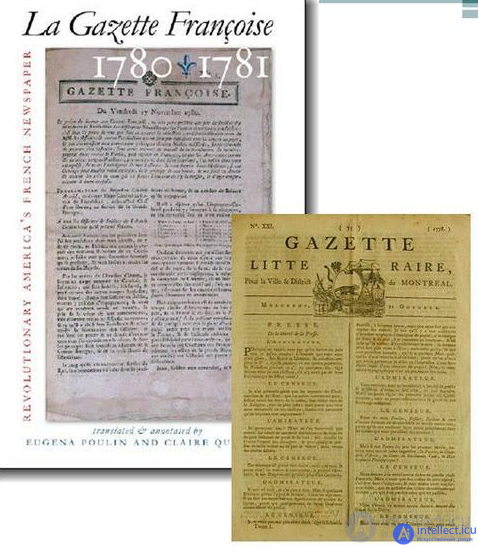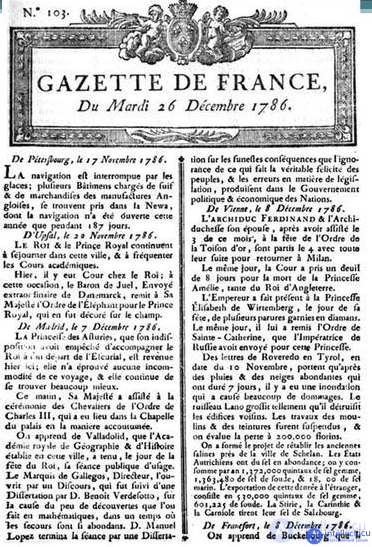Lecture
The forerunners of the first French newspapers were the so-called Canards - a kind of journalistic folklore. Newsletters in which various events were narrated. Most often sensational. The texts were different in genre — news article, everyday story, anecdote. Enjoyed great popularity. Written in simple language, intended to entertain. Journalism in France began to develop later than in Germany and England, but as researchers note, it was distinguished by its dynamism and liveliness. Gradually, Canardas began to print like whole brochures.
The work Relation de ce qui s'est passé en la Nouvelle France en l'année 1634 (Relation of what happened in New France in 1634), without a doubt, is the best example from Religion of the Jesuits , published in Paris from 1632 to 1673. This work, written by the French missionary Paul Le Jeun (1592−1664), is known for its literary merits, as well as for the observation of the Montagnier Indians. Le Jeun, a native of the city of Chalons-sur-Marne in the Champagne region, was a novice of the Jesuit order for two years from 1613 to 1615. He then studied philosophy at the College of Henry IV in La Flash, where he met in the father of Enemon Massa (1575-1646), who returned from Acadia. Masset aroused interest in missionary work in faraway lands in Le Jeunet. In 1624, Le Jeun was ordained a priest, and in 1631 he was appointed head of the Jesuit mission in Canada. Arriving in Quebec the following year, he aroused great enthusiasm in the colony for missionary work. For the sake of studying the Indian languages, Le Jeun in the winter of 1633-1634 decided to go with a group of Indians Montagnier on a hike along their hunting grounds. For almost six months he suffered cold, hunger and fatigue from long snowshoe crossings. During the campaign, he was faced with ridicule, and at times - with open hostility from the main shaman, Montagnier Carigonan, whom, according to some historians, he himself partially provoked. This journey convinced Le Jeun that the conversion of the Indians to Christianity is impossible without a transition to a settled lifestyle. At the end of the campaign, he wrote his brilliant "Relation on the events of 1634." Demonstrating the talent of the writer, Le Jeun also created an extremely interesting ethnographic description of Montagnier society in the 17th century.
The first printing house in France was in 1475 at the oldest French university in the Sorbonne. Perirdic publications in France appeared later than in Germany and England, but daily life was of interest to the first French chroniclers.


La Gazette appeared once a week on 4 pages. The first issue contained news (mainly two weeks ago) from Rome, Prague, and Constantinople. Topics - trade, war, court chronicle, diplomatic news.
40 The La Gazette circulation of the first years of publication did not exceed 1,200 copies, the uniform numbering of the issues remained, and after a year the Recueil des Gazettes (La Gazette Annual Collection) was published. Since 1762, the newspaper staa came out as an official publication called “La Gazette de France”, which lasted until 1944.
By the end of the 15th century, there were about 50 printing houses in France. In the 16th century, the publishing business was completely under the control of the monarch. The license was issued by the king. Most often, printing houses printed various chronicles of court life and diplomatic relations, religious content. Some religious publications were printed in 1,000 copies.
Almanacs and calendars produced by French printing houses already carried an element of a clear periodicality.
If you live in Paris in the 19th century, then most likely you can read: at the beginning of the century, there were only about 16% of the illiterate in the city (against 39% in France as a whole), and by the end - 3-4% for all. Most Parisians read newspapers, which from the mid-1830s began to redirect part of the sheet to short stories and novels. So, for example, Balzac and the father of Alexander Dumas publish their works. You can subscribe to a newspaper, but it is very expensive, so most Parisians read in cafes or in special reading rooms, where you can get it by subscription, or you can pay for one visit. The choice of study to read depends on your financial capabilities: from luxurious, with rich collections of books and elegant furniture, to simple writing desks with newspapers, standing right on the street in places for walking.
In the thirties, the city had about forty libraries, but only some of them had free access. These are state libraries (the Royal Library and the libraries of Saint-Genevieve, Arsenal and Mazarin), as well as the City Library, the library of the Conservatory of Decorative and Applied Arts and the library of the Museum of Natural History in the Botanical Garden. ,
In 1837, the Polytechnic Association, which organized evening courses for workers, opened its own library, but the main wave of opening working libraries and libraries of various unions and societies took place in the 1860s. The first of these is the library of the Society of Friends of Education, which opens in 1861.
In the second half of the century, books become cheaper and more affordable. In the 1860s, the city hall began to engage in libraries - municipal libraries appeared in the city, which are located in different quarters and offer non-specialized literature to local residents. In 1879, there were 14 libraries in Paris subsidized from the city budget. In 1894, 70 libraries published over 150,000 books and over 1,600,000 books for home use in the room.
Comments
To leave a comment
Journalism History
Terms: Journalism History